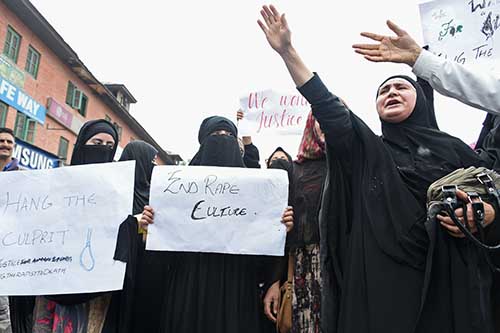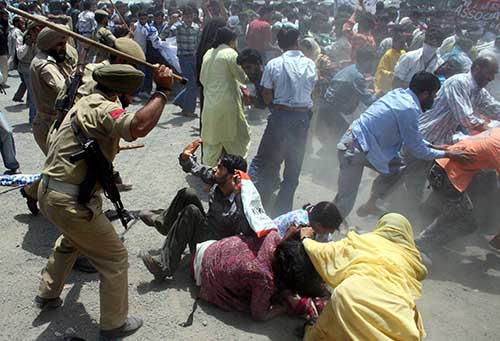The US-based writer is a Ph.D. & works for The George Washington University. He hails from occupied Kashmir and regularly speaks against the gross human rights violations committed by the Indian security forces in this disputed Muslim-majority region.
Sexual assaults of women by the occupation forces during wartime or while crushing the freedom struggle has occurred throughout history. Use of rape as weapon of war was horrifically demonstrated during World War-II when both the allied and the axis forces terrorised civilian population by performing these gruesome acts. In the second-half of the 20th century, cases of rape were documented in more than 20 military conflicts. Due to the prevalence of rape in Balkan and Rwanda conflicts, the international community began to recognise rape as an important war strategy and efforts were made to prosecute such acts under the international law. The primary statute, Article 27 of the Geneva Convention (1949) relates to the protection of civilians during war and specifically included clauses “against any attack on their honor” in particular rape. In 1993, the UN commission on human rights declared systematic rape as a crime against humanity. The jurisdiction of international tribunals established to prosecute crimes in former Yugoslavia and Rwanda, including rape as a war crime. In a landmark case in 1998, the Rwandan tribunal ruled that rape and sexual assault constitute a genocide. In 2008, the government of Congo increased efforts to document rape crimes and these cases were documented in 2008 movie “Greatest Silence” by filmmaker Lisa Jackson.
Against this backdrop, it is fair to state that the conflict in Indian occupied Kashmir (IoK) has beleaguered the region since the independence of the sub-continent from the British Raj in 1947.
The one big difference between the occurrences in Indian-held Kashmir and other parts of the world like Balkans or Rwanda is that cataclysm of violence in that Muslim-majority region remain unnoticed, and treated by world community in an unobtrusive manner. Prior to the ongoing resistance movement, mass rapes were carried out by the Dogra troops as well as Hindu and Sikh mobs during 1947 Jammu massacres. Numerous scholars and human right organisations firmly propound that since the onset of the agitation for achieving freedom, the Indian occupation forces — comprising Indian Army, the CRP (Central Reserve Police) and the BSF (Border Security Force) have leveraged rape as a weapon for combating the peaceful resistance of the unarmed Kashmiris.
Most frequent strategy implemented by occupation forces since early 1990 is incessant crackdowns in which men are forced to leave the dwellings and searches are performed. In this scenario, properties are destroyed, valuables are confiscated and women are molested. While in this limited space it is not possible to mention every such incident, but they are well-documented in a 900-page report authored by highly reputed and internationally recognised human right activist, Khurram Parvez, who is currently languishing in a notorious prison of Delhi under frivolous charges. It is believed that since the initiation of the freedom movement in occupied Kashmir in 1990, at least 11,300 Kashmiri women have been gang-raped. However, it is reckoned that due to the fear of social ostracisation, a large number of such cases go unreported, and the actual figures are much higher. The first reported rape case in IoK was that of a 26 -year-old woman from Jamir Qadeem in Sopore district in 1990. She was raped during a search operation. Since then, these actions continue and to-date women in IoK continue to be tormented by the Indian occupation army. In this space I will mention two major incidents where occupation forces indulged in mass rape of Kashmiri women and the perpetrators of these heinous crimes were allowed to escape scot free.
On the night of February 23, 1991, under the garb of performing a so-called “search operation,” officials belonging to the CRP and the BSF cordoned off the twin villages of Kunan and Poshpora. As usual men were ordered to leave their residences and assemble in a nearby field. The Indian forces entered the houses and caused a rampage. About 70-80 women were gang-raped. The age of the victims ranged from 12 -80 years, and one of them was pregnant, who later on delivered a baby with a broken shoulder. The government of India discounted these well substantiated reports and the culprits went unpunished.
Few years ago, a group of young women lawyers took the risk of interviewing the victims and published it in the form of a book, which provides graphic details about the monstrous crimes committed by the Indian forces. It is learnt these young lawyers had to go in the hiding as they are receiving threatening calls by the Indian agencies. Another incident known as Asiya-Nilofer case in which these two young women– both sisters-in-laws — hailing from village Bongam of Shopian district, were kidnapped from their orchard by the members of occupation forces, gang raped, murdered and their bodies thrown on the banks of a nearby stream. When the locals discovered their bodies, they took them to the hospital and the attending doctors performed an autopsy. The examination proved that the women were raped, which led to severe public resentment. This led to the imposition of an undeclared curfew in the area and number of demonstrators were arrested and subjected to torture. To contradict the report of local doctors, the CBI (Central Bureau of Investigations) team was dispatched to the area, which exhumed and examined bodies of the victims. It was claimed that rape never occurred and the women died from drowning in a rivulet. This was an ultimate falsehood as I know the area and along with my three-year-old son, I have traversed through this water body. As a consequence of this fallacious report, severe action against local doctors was taken and they were terminated from their services. Also this was a strong message to the medical community to follow the line of the government or face the repercussions.

The facts mentioned above underlines the world community’s apathy towards the bestial acts committed by the Indian state against Kashmiris. All these Indian brutalities fall under the purview of “crimes against humanity.” This can be explained by the fact that the Indian government does not allow foreign journalists, UN teams or the International Red Cross in the region. India denies these incidents, using its well-oiled propaganda machinery that has spread its tentacles all over the world. Conversely, Pakistan’s role in highlighting these atrocities remains tardy and for unknown reasons, Islamabad has exhibited a reluctance to take up the cases of human rights violations in occupied Kashmir to the International Court of Justice. Islamabad also appears at a loss to formulate any effective and viable strategy to counter the dis-information campaign emanating from India and its agencies in the world.

In this regard, the obsequious attitude by the current Pakistani rulers is reprehensible, and the desire by the former army chief, Qamar Javed Bajwa, to build bridges with India without addressing the Kashmir issue is like throwing cold water on the aspirations of Kashmiris and disregarding their insurmountable sacrifices. At the non-governmental level, the Kashmiri diaspora contacted several women rights groups, but to their utter dismay even the head of one of the prominent rights organisations in Pakistan refused when asked to highlight Indian atrocities in general and crimes committed against the women in particular. It was subsequently learnt that the unwillingness was linked to her relations with the Indian agencies that sponsored her visits and showered her with bestowals. This relation of quid-pro-quo between the civil right groups in Pakistan and the Indian agencies has severely damaged the Kashmir cause and dampened the hopes of highlighting the atrocities inflicted by occupation forces on the people.
In addition to the Pakistani government and the human rights organization, forums like OIC (Organization of Islamic Cooperation) have also failed to take up the Kashmir case effectively. All the pleas have led to a meek response and the Indian government has not received even a slap on the wrist.
According to the latest World Bank report, India receives remittances worth $43 billion from the UAE and $34.4 billion from Saudi Arabia. This forms the backbone of the Indian economy and even a threat of sanctions from these two countries has the potential to cause an economic disarray in the world’s so-called largest democracy. The most appalling fact is that both these Islamic countries not only reward the Indian companies with lucrative contracts, but they even bestowed the highest civilian award to Prime Minister Narendra Modi – the man responsible for the crimes against humanity in occupied Kashmir as well as the mass killings of Muslim men and rape of their women in Gujrat in 2004. At that time, Modi, on whose orders these killings and rapes were committed, was serving as the chief minister of Gujrat.
This has been elaborately demonstrated in a recent BBC documentary against which the Indian government has raised hue and cry and banned it across India, including on the social media platforms.
It remains a cruel irony that Modi was especially flown by former premier Nawaz Sharif to his private residence, where he was given a red-carpet treatment.
It is a sad fact that Saudi Arabia and all the other Muslim countries overwhelmingly are acting as silent spectators as India pushes its nefarious plan of transforming Kashmiri Muslims into a minority on their own land. Also, the extremist Hindu government of Modi is carrying out the worst kind of religious persecution of 220 million Muslims living in India. The OIC needs to establish its credentials by speaking against the suppression of Muslims by India.
As the world act as a silent spectator, at least the women rights groups in Pakistan can up the following steps to highlight the plight of Kashmiri women:
- There should be a special mention of the atrocities committed against Kashmiri women by India on all the events planned to mark the International Women’s Day.
- Pakistani television channels should regularly telecast programmes to create awareness about the Kashmir cause and fight its case.
- Every year on February 23, victims of the Kunan-Poshpora tragedy should be remembered both nationally and internationally. All the Pakistani diplomatic missions, including embassies and consulates across the world, should hold lectures to highlight the day, inviting dignitaries and leaders of public opinion there.
- Pakistani universities and colleges should organise seminars and symposiums on the sufferings of Kashmiri women.
- There is also a need to organise art exhibitions, depicting the Indian atrocities inflicted on Kashmiri women by involving local and foreign artists.
- Efforts should be made to build a memorial to honour the Kashmiri women.
- Finally, and most importantly, women rights groups in Pakistan should impress on their government to take the cases of mass rapes in IoK to the International Court of Justice so that culprits are made accountable and victims receive justice.
It is time to wake up from our deep slumber and act. Let’s speak up for the brave Kashmiri women and raise their plight at every available forum. The victims of Indian atrocities should know that their sufferings and sacrifices will never be forgotten and we will continue our struggle until Kashmir wins its freedom from India.



